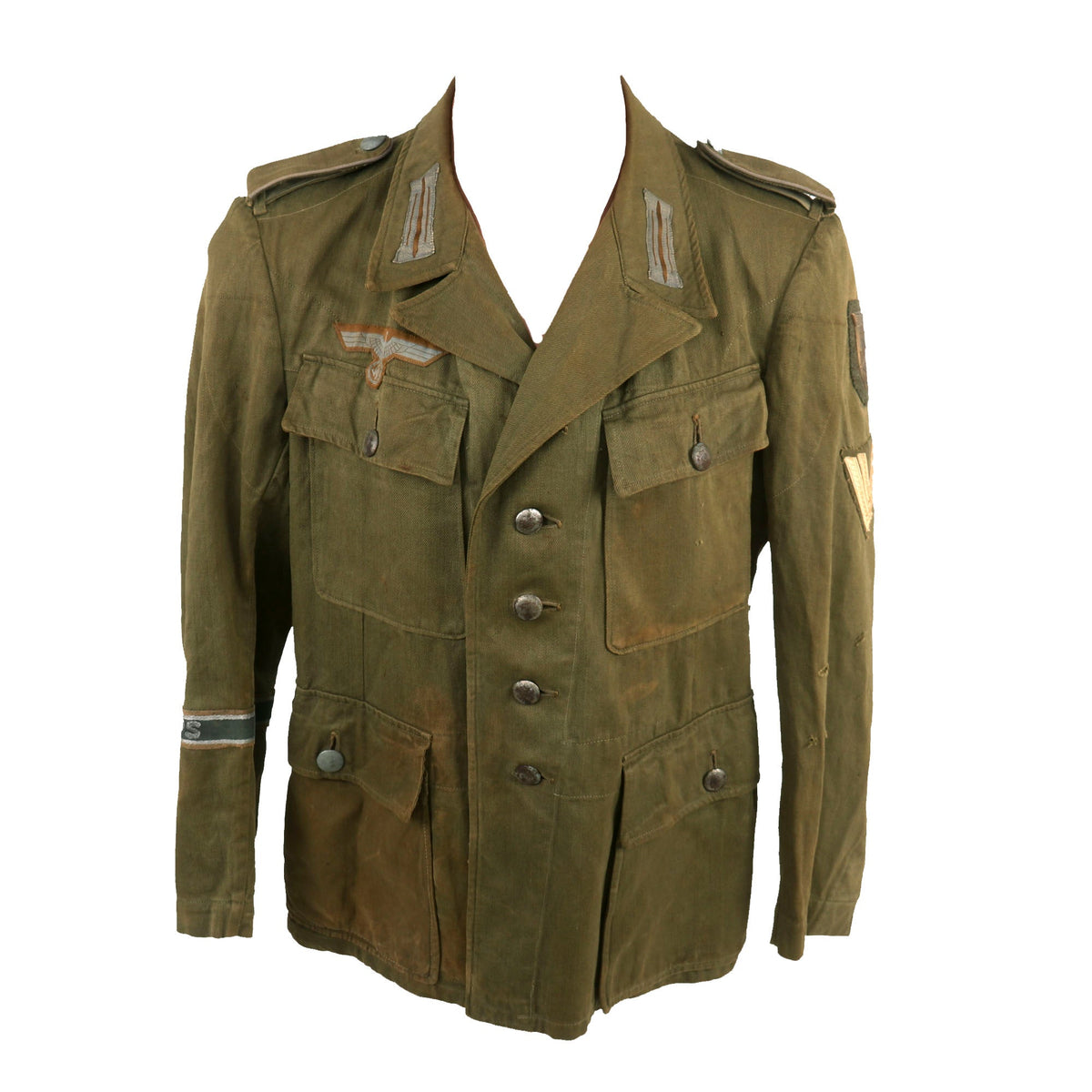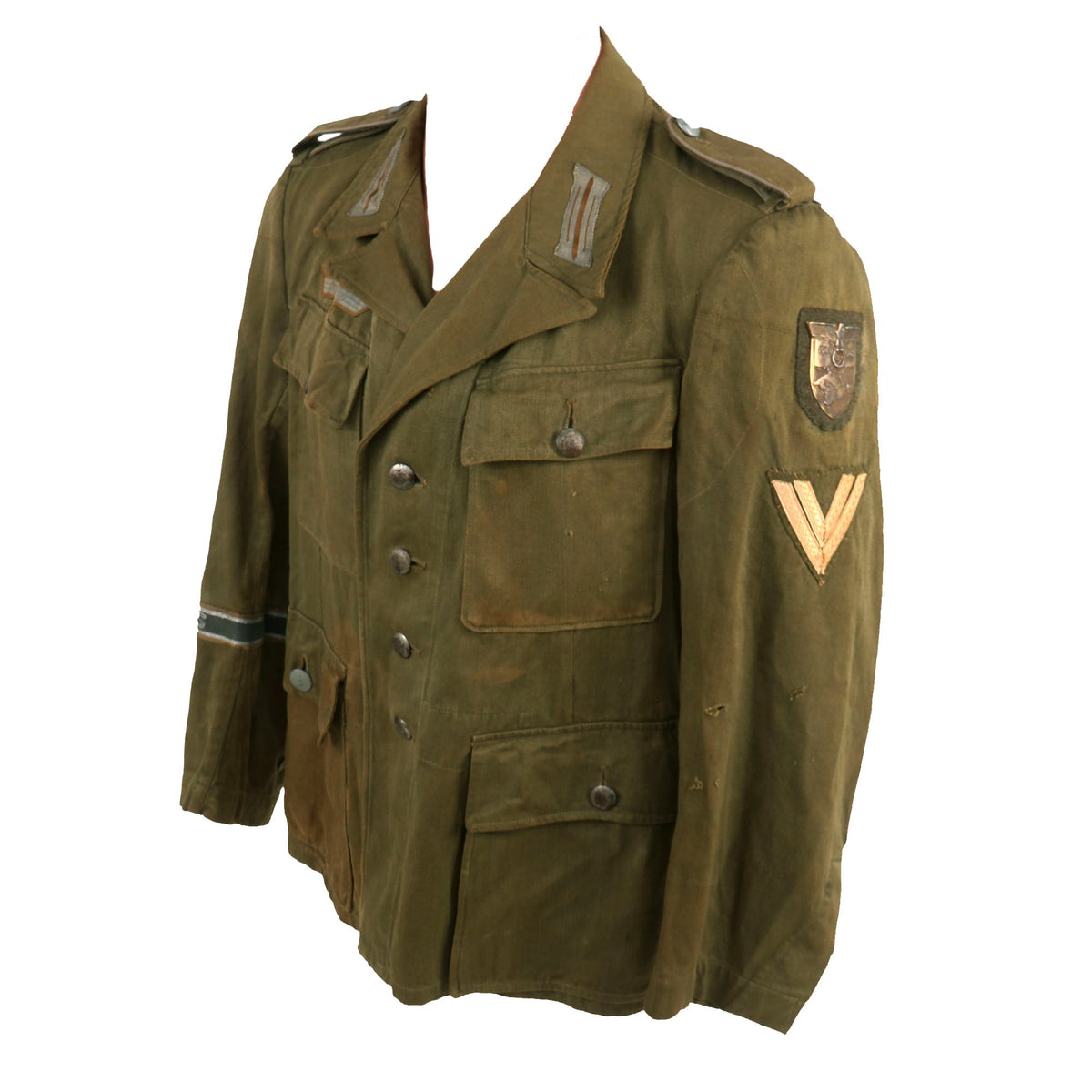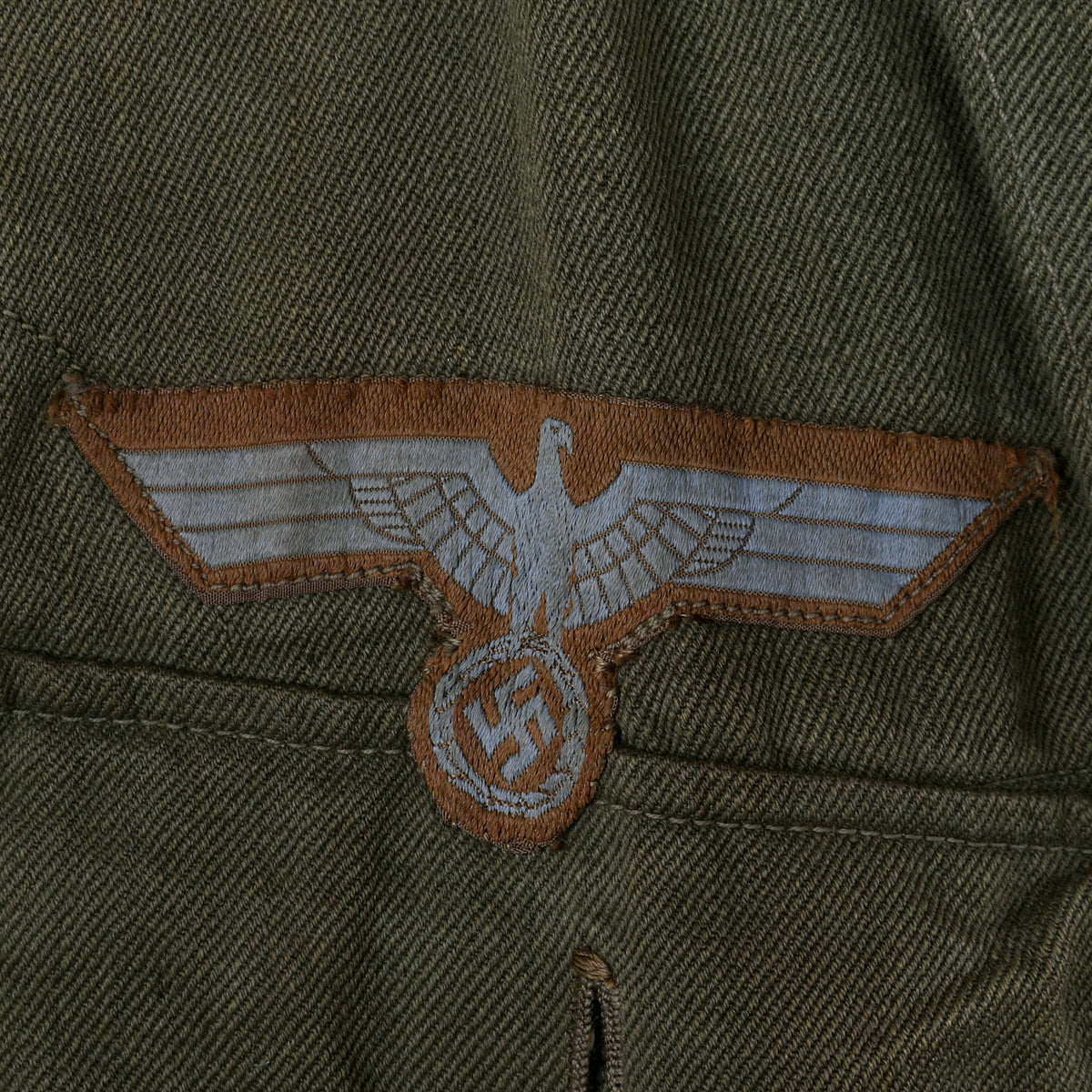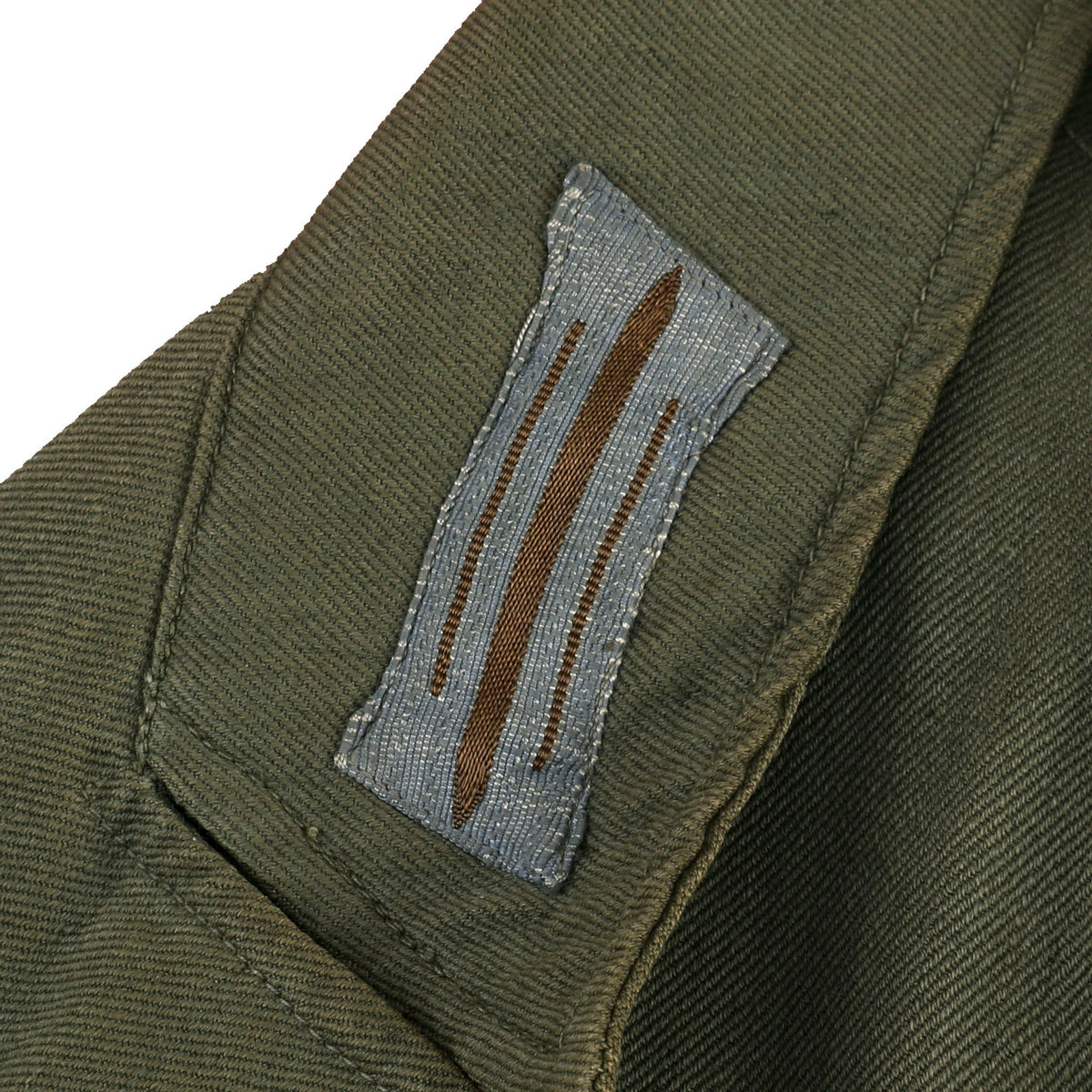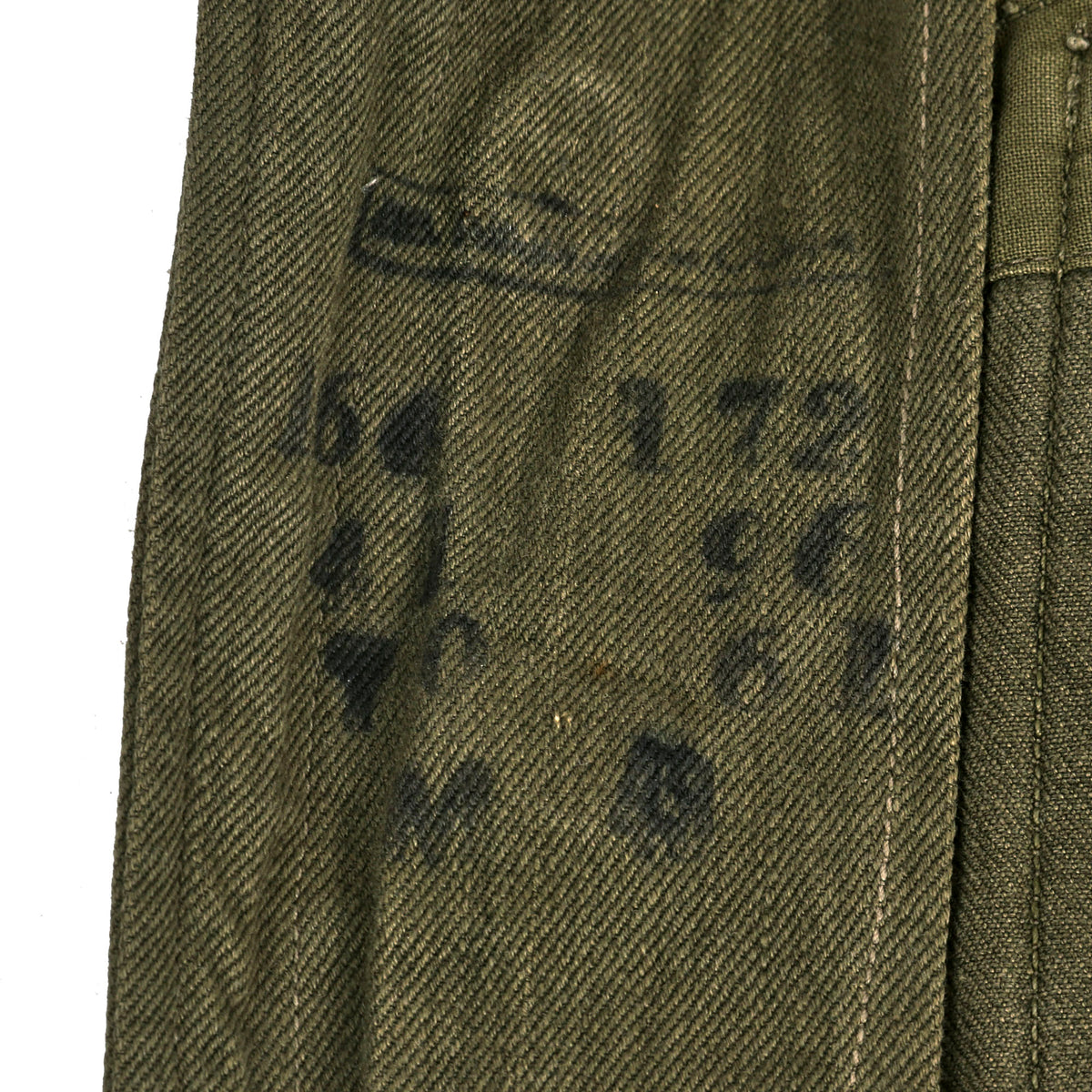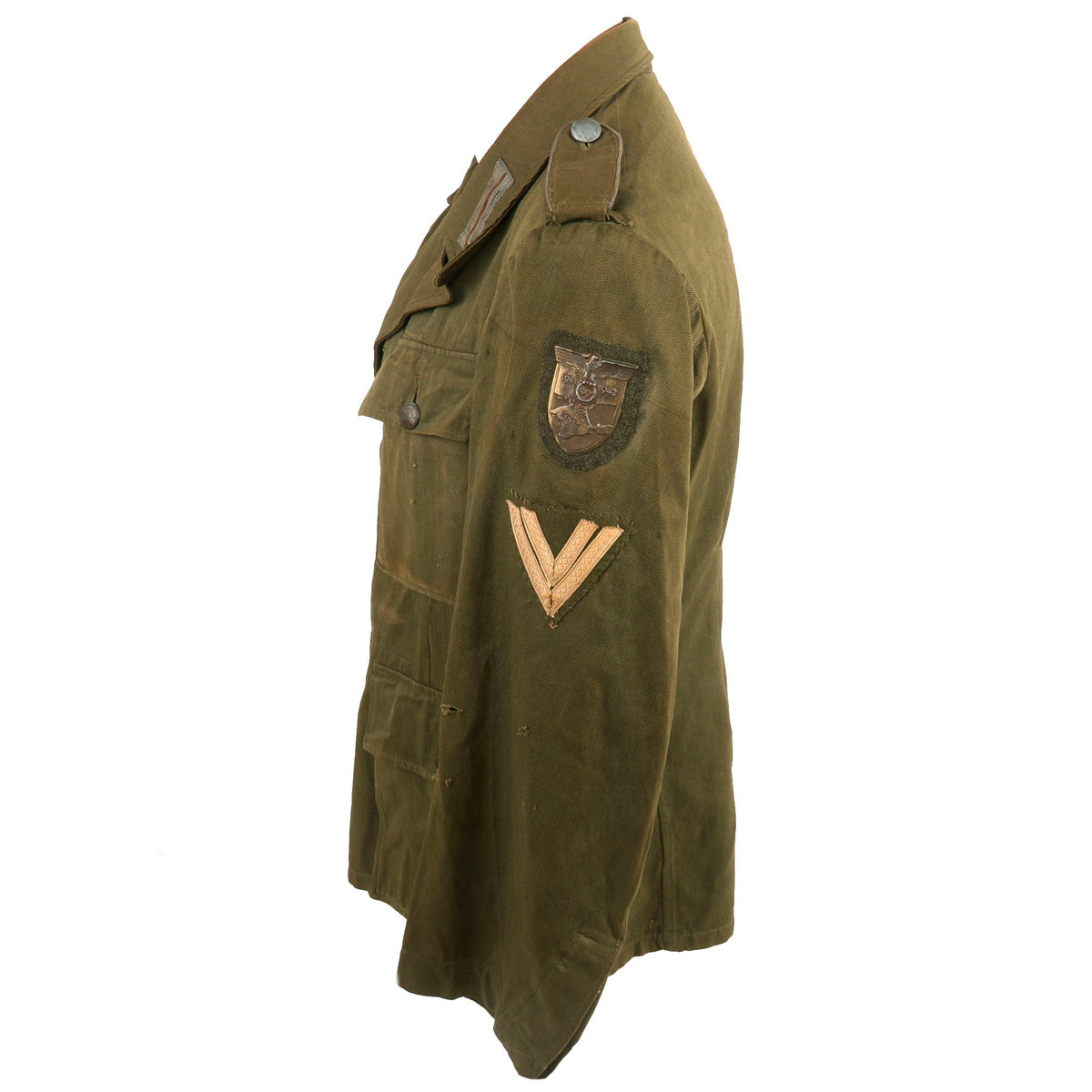Original German WWII 1943 Dated Obergefreiter’s M43 Tropical Afrika Korps Transport & Logistics EM Tunic with Krim Shield Post War Re-Applied Original Items
$ 2.395,00 $ 598,75
Original Item: One-of-a-kind. In early 1941, the German military began their conquest of southern Europe. Due to the warmer climates of these areas, the German Army needed to equip its troops with a more suitable form of dress, and replace the standard wool based feldgrau uniforms. The new “tropical” uniforms were lighter in weight, and dyed in colors ranging from light tan to dark olive.
This 100% authentic German World War Two M43 Heer Tropenbluse Tropical Tunic is in very good lightly used condition. The tunic is made out of lightweight cotton twill weave denim-like material which has been dyed a darker olive/tan. It features four flat front pockets with square pockets, which identifies this as the later M43 model. The first model, the M41, had pleated pockets, the second model, the M42, had scalloped pockets, and the third and final model, the M43, had square pocket flaps like this example.
The tunic has a faded RBNr. maker and size markings on the interior, which can still be read for the most part:
[ILLEGIBLE RBNr. STAMP]
64 172
41 96
70 61
M 43
The M indicates manufacture at the Munich Depot, while the 43 indicates a manufacture date of 1943.
The tunic features a BeVo tropical Heer Breast eagle, with the correct blue threads on a tan background. It has the correct tropical EM litzen on each side of the collar opening. On the left shoulder, a Krimschild Badge with its original wool backing is sewn on, and right below that is a set of tropical heer rank chevrons for the rank of Obergefreiter, which features two gold chevrons on wool backing. The lower right sleeve has an Afrikakorps Ärmelstreiffen (Africa Corps Cuff Title) sewn to it, which is the later BeVo embroidered pattern with a Latin AFRIKAKORPS marking, and totally correct.
The shoulders both bears button-attached style tropical Heer Mannschaften schulterklappen (Army Enlisted shoulder straps or epaulets) with Hellblau (Light blue) piping, the Corps Color (Waffenfarbe) for Transportation troops (Fahrtruppen) until 1942 and Supply troops (Nachschubtruppen) from 1942 onwards. They have faded in the sun, so they look almost gray, but on the underside the original color is still retained.
The Krim Shield appears to be the only piece of insignia that was post-war reapplied. The rest of the insignia shows evidence of wartime application, therefore making this tunic a very scarce example, as most had their insignia torn off.
The front of the tunic has five original pebbled buttons for the main closure, and four pocket buttons, all of which were originally a nice green color, but now only a few buttons still have a good amount of the finish present. The majority show a gray oxidized zinc patina. The two shoulder buttons for the rank insignia are identical, and all look to be made from non-magnetic zinc or aluminum, and are maker-marked on the back to two different makers. All of these buttons are held in place with steel circlip retainers, except for the shoulder buttons, which are sewn on directly.
Overall condition is very good, showing light wear and discoloration from service. There is a small bit of service tearing on the sleeve as shown, but it has a great lightly worn look overall. A fantastic totally genuine Afrika Korps M43 tunic in great service used condition. Ready for further research and display!
Approximate Measurements:
Collar to shoulder: 9.5″
Shoulder to sleeve: 23”
Shoulder to shoulder: 14”
Chest width: 19″
Waist width: 18″
Hip width: 20.5″
Front length: 27.5″
The Crimea Shield (Krimschild or KRIM Shield) was a World War II German military decoration awarded to military personnel under the command of Generalfeldmarschall Erich von Manstein who fought against Soviet Red Army forces and captured the Crimea region (Krim in German) between 21 September 1941 and 4 July 1942. It was instituted on 25 July 1942. The shield is headed by the German eagle clutching a laurel wreath surrounding a swas. Flanking the eagle are the dates 1941 and 1942, which represent the start and end dates of the campaign. This sits on the backdrop of the Crimean peninsula, where the fighting took place, which has the word KRIM stamped across it.
The Afrika Korps or German Africa Corps (Deutsches Afrikakorps or DAK) was the German expeditionary force in Africa during the North African Campaign of World War II. First sent as a holding force to shore up the Italian defense of their African colonies, the formation fought on in Africa, under various appellations, from March 1941 until its surrender in May 1943. The term “Afrika Korps” is pseudo-German (so-called “cod-German”), deriving from an incomplete German title. The German term referred solely to the initial formation, the Deutsches Afrikakorps (DAK), which formed part of the Axis command of the German and Italian forces in North Africa. The name stuck, with both news media and Allied soldiers, as the name for all subsequent German units in North Africa. The unit is known for having been commanded by Field Marshal Erwin Rommel.
Fast Shipping with Professional Packaging
Thanks to our longstanding association with UPS FedEx DHL, and other major international carriers, we are able to provide a range of shipping options. Our warehouse staff is expertly trained and will wrap your products according to our exact and precise specifications. Prior to shipping, your goods will be thoroughly examined and securely secured. We ship to thousands clients each day across multiple countries. This shows how we're dedicated to be the largest retailer on the internet. Warehouses and distribution centres can be located throughout Europe as well as the USA.
Note: Orders with more than one item will be assigned a processing date depending on the item.
Before shipping before shipping, we'll conduct a thorough inspection of the items you have ordered. Today, the majority of orders will be delivered within 48 hours. The delivery time will be between 3-7 days.
Returns
The stock is dynamic and we cannot completely manage it because multiple stakeholders are involved, including our factory and warehouse. So the actual stock may alter at any time. It's possible that you may not receive your order once the order has been made.
Our policy is valid for a period of 30 days. If you don't receive the product within 30 days, we are not able to issue a refund or an exchange.
You can only return an item if it is unused and in the same state as the day you received it. You must have the item in its original packaging.
Related products
Uncategorized
Uncategorized
Uncategorized
Uncategorized
Uncategorized
Angolan Rebel 1970s era 60mm Inert Display Mortar from Angolan Civil War Original Items
Uncategorized
Uncategorized
Uncategorized
Uncategorized
Uncategorized
Armored Burgonet Helmet & Polearm from Scottish Castle Leith Hall Circa 1700 Original Items
Uncategorized
Uncategorized
Uncategorized
Uncategorized
Uncategorized
Uncategorized
Uncategorized
